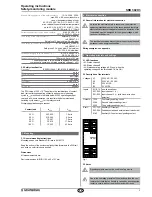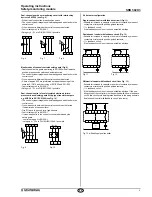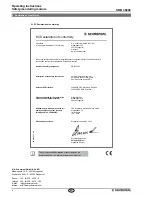
3
SRB 302X3
Operating instructions
Safety-monitoring module
EN
Max. switching capacity of the safety contacts:
13-14, 23-24, 33-34:
max. 250 V, 8 A ohmic (inductive in
case of suitable protective wiring);
AC-15: 230 VAC / 6 A, DC-13: 24 VDC / 6 A;
max. residual current at ambient temperature
up to: 45°C: 24 A / 55°C: 21 A / 60°C: 18 A;
24 VDC / 6 A; min. 10 V / 10 mA
Switching capacity of the auxiliary contacts:
41-42: 24 VDC / 2 A
Y31-Y32: 24 VDC / 500 mA
Fuse rating of the safety contacts:
external (I
k
= 1000 A)
to EN 60947-5-1
Safety fuse 10 A quick blow, 8 A slow blow
Fuse rating for the auxiliary contacts:
41-42: external (I
k
= 1000 A)
to EN 60947-5-1
Safety fuse 2.5 A quick blow, 2 A slow blow;
Y31-Y32: 0.5 A slow blow
Utilisation category to IEC/EN 60947-5-1:
AC-15: 230 VAC / 6 A
DC-13: 24 VDC / 6 A
Dimensions H x W x D:
100 mm × 45 mm × 121 mm
The data specified in this manual are applicable when the
component is operated with rated operating voltage U
e
±0%.
2.5 Safety classification
Standards:
EN ISO 13849-1, IEC 61508, EN 60947-5-1
PL:
up to e
Control category:
up to 4
DC:
99% (high)
CCF:
> 65 points
PFH value:
≤ 2.00 × 10
-8
/h
SIL:
up to 3
Service life:
20 years
The PFH value of 2.00 × 10
-8
/h applies to the combinations of contact
load (current through enabling contacts) and number of switching
cycles (n
op/y
) mentioned in the table below. At 365 operating days per
year and a 24-hours operation, this results in the below-mentioned
switching cycle times (t
cycle
) for the relay contacts.
Diverging applications upon request.
Contact load
n
op/y
t
cycle
20 %
525,600
1.0 min
40 %
210,240
2.5 min
60 %
75,087
7.0 min
80 %
30,918
17.0 min
100 %
12,223
43.0 min
3. Mounting
3.1 General mounting instructions
Mounting: snaps onto standard DIN rails to EN 60715.
Snap the bottom of the enclosure slightly tilted forwards in the DIN rail
and push up until it latches in position.
Dimensions
All measurements in mm.
Device dimensions (H/W/D): 100 x 45 x 121 mm
4. Electrical connection
4.1 General information for electrical connection
As far as the electrical safety is concerned, the protection
against unintentional contact of the connected and therefore
electrically interconnected apparatus and the insulation of the
feed cables must be designed for the highest voltage, which
can occur in the device.
The electrical connection may only be carried out by authorised
personnel in a de-energised condition.
Wiring examples: see appendix
5. Operating principle and settings
5.1 LED functions
• K1: Status channel 1
• K2: Status channel 2
• U
B
: Status operating voltage (LED is on, when the
operating voltage on the terminals A1-A2 is ON)
5.2 Description of the terminals
Voltages:
A1
A2
B1
B2
230 VAC / 115 VAC
230 VAC / 115 VAC
24 VAC/DC
0 VAC/DC
Inputs:
S11-S12
S21-S22
S31-S32
one-channel input
Input channel 1 (+)
Input channel 2 (–) (with cross-wire short
detection)
Outputs:
13-14
23-24
33-34
First safety enabling circuit
Second safety enabling circuit
Third safety enabling circuit
Start:
Y31-Y32
S33-S34
41-42
Auxiliary NO contact
Feedback circuit and external reset (monitored)
Auxiliary NC contact as signalling contact
SRB 302X3
23
S12
B1
S32
S31
K2
K1
UB
13
A1
S13
33
S14
41
24
Y32
34 42
S21 S22
Y31
14
B2
S33 S34
A2
S11
Fig. 1
5.3 Notes
Signalling outputs must not be used in safety circuits.
Due to the operating principle of the electronic fuse, the cus-
tomer must check that no hazard is caused by an unexpected
restart in circuits without reset button (automatic reset).
























